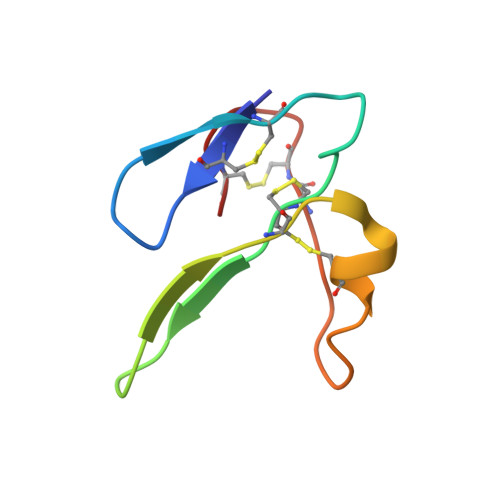Structural insights into the evolution of a sexy protein: novel topology and restricted backbone flexibility in a hypervariable pheromone from the red-legged salamander, Plethodon shermani.
Wilburn, D.B., Bowen, K.E., Doty, K.A., Arumugam, S., Lane, A.N., Feldhoff, P.W., Feldhoff, R.C.(2014) PLoS One 9: e96975-e96975
- PubMed: 24849290
- DOI: https://doi.org/10.1371/journal.pone.0096975
- Primary Citation of Related Structures:
2MHY - PubMed Abstract:
In response to pervasive sexual selection, protein sex pheromones often display rapid mutation and accelerated evolution of corresponding gene sequences. For proteins, the general dogma is that structure is maintained even as sequence or function may rapidly change. This phenomenon is well exemplified by the three-finger protein (TFP) superfamily: a diverse class of vertebrate proteins co-opted for many biological functions - such as components of snake venoms, regulators of the complement system, and coordinators of amphibian limb regeneration. All of the >200 structurally characterized TFPs adopt the namesake "three-finger" topology. In male red-legged salamanders, the TFP pheromone Plethodontid Modulating Factor (PMF) is a hypervariable protein such that, through extensive gene duplication and pervasive sexual selection, individual male salamanders express more than 30 unique isoforms. However, it remained unclear how this accelerated evolution affected the protein structure of PMF. Using LC/MS-MS and multidimensional NMR, we report the 3D structure of the most abundant PMF isoform, PMF-G. The high resolution structural ensemble revealed a highly modified TFP structure, including a unique disulfide bonding pattern and loss of secondary structure, that define a novel protein topology with greater backbone flexibility in the third peptide finger. Sequence comparison, models of molecular evolution, and homology modeling together support that this flexible third finger is the most rapidly evolving segment of PMF. Combined with PMF sequence hypervariability, this structural flexibility may enhance the plasticity of PMF as a chemical signal by permitting potentially thousands of structural conformers. We propose that the flexible third finger plays a critical role in PMF:receptor interactions. As female receptors co-evolve, this flexibility may allow PMF to still bind its receptor(s) without the immediate need for complementary mutations. Consequently, this unique adaptation may establish new paradigms for how receptor:ligand pairs co-evolve, in particular with respect to sexual conflict.
Organizational Affiliation:
Department of Biochemistry and Molecular Biology, University of Louisville, Louisville, Kentucky, United States of America.














